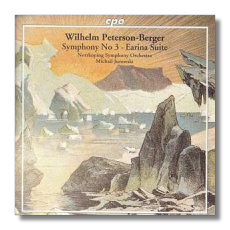
The Internet's Premier Classical Music Source
Related Links
- Latest Reviews
- More Reviews
-
By Composer
-
Collections
DVD & Blu-ray
Books
Concert Reviews
Articles/Interviews
Software
Audio
Search Amazon
Recommended Links
Site News
 CD Review
CD Review
Wilhelm Peterson-Berger

Symphony #3
- Symphony #3 "Same Ätnam"
- Earina Suite
- The Doomsday Prophets: Chorale and Fugue
Norrköping Symphony Orchestra/Michail Jurowski
CPO 999632-2 70:55
The CPO label has been working its way through the symphonies of Wilhelm Peterson-Berger (1867-1942) – he completed five – and both the series and the symphonies have been getting good reviews. I recommended Symphony #2 in Fanfare, and colleague Paul Snook called cpo's recording of Symphony #1 "a mandatory acquisition for all lovers of Scandinavian Romanticism."
Peterson-Berger was an influential and, at times, unpleasantly frank music critic for a major Swedish paper. When he wrote music of his own, performers and other critics often acted on the principle that turnabout was fair play. His music is infrequently heard outside of Sweden. A cycle of piano works called Frösöblomster (Flowers of Frösö) is very popular in his own country, and a recent recording of this cycle on the Naxos label will surely spread its appeal, just as this CPO series is spreading the composer's name throughout the rest of the world.
"Peterson-Berger," as he signed his reviews, was an advocate of Wagner, although this is not obvious from what little of his music I've heard. His music sounds less typically Scandinavian than that of Carl Nielsen, for example. Overall, it is influenced by Peterson-Berger's studies in Dresden, and there are hints of inspiration from southern Europe (particularly Italy) and the French school of the time.
The Third Symphony (1913-15) is also known as the "Symfonia Lapponica" because it utilizes melodies from Lapland. It is appealing, fresh, and redolent of the open air, and the composer's use of the harp and an orchestral piano lend the symphony, particularly the first movement, a glittering quality. The first movement is a nature piece that incorporates thematic material about a river and a mountain. At times the music is imposing, and at other times it is inviting, but one can't mistake the hint of danger that pervades this movement. The same hint is present in the second movement, a bracing Scherzo that suggests a sleigh-ride under the Northern Lights. The slow third movement, a depiction of a night in summer, starts off with a fugue, and ends with the song of a Lapp youth affected by a kind of existential sorrow. The finale is masculine and forthright. It illustrates expansion into Lapland by people from the south, and its "can do" attitude prevails up until the end, when the Lapp youth's song returns to bring the symphony to a quiet, surprising close.
Earina (the word is derived from Greek, and it connotes something spring-like) is a suite of five brief pieces originally written for the piano. composed and then orchestrated them in 1917. The melodies are charmingly antiquated, and this is a less ambitious work than the symphony. Although the annotator writes that Earina "gives voice to the northerner's longing for the sunny south," I find this to be a more typically Scandinavian work than the Third Symphony. Finally, The Doomsday Prophets is a comic opera that the composer completed in the same year. Apparently it is like a Swedish Die Meistersinger, and its title alludes to learned squabbles over the precise predicted date of the apocalypse. The Chorale and Fugue are purely orchestral; they were arranged from the opera by conductor Gunnar Johansson in 1970, so, strictly speaking, this is not Peterson-Berger's work. These excerpts convey a ceremonial, even pompous attitude, and also humor – not unlike Wagner's opera.
Jurowski seems very comfortable with the idiom, as does the orchestra, although the Norrköping Symphony Orchestra doesn't consistently offer first-class intonation, as well as all the sparkle I imagine that these works could have. Still, the performances should turn no one away from this enjoyable music. cpo's engineering emphasizes a natural sound-picture.
Copyright © 2000, Raymond Tuttle



















